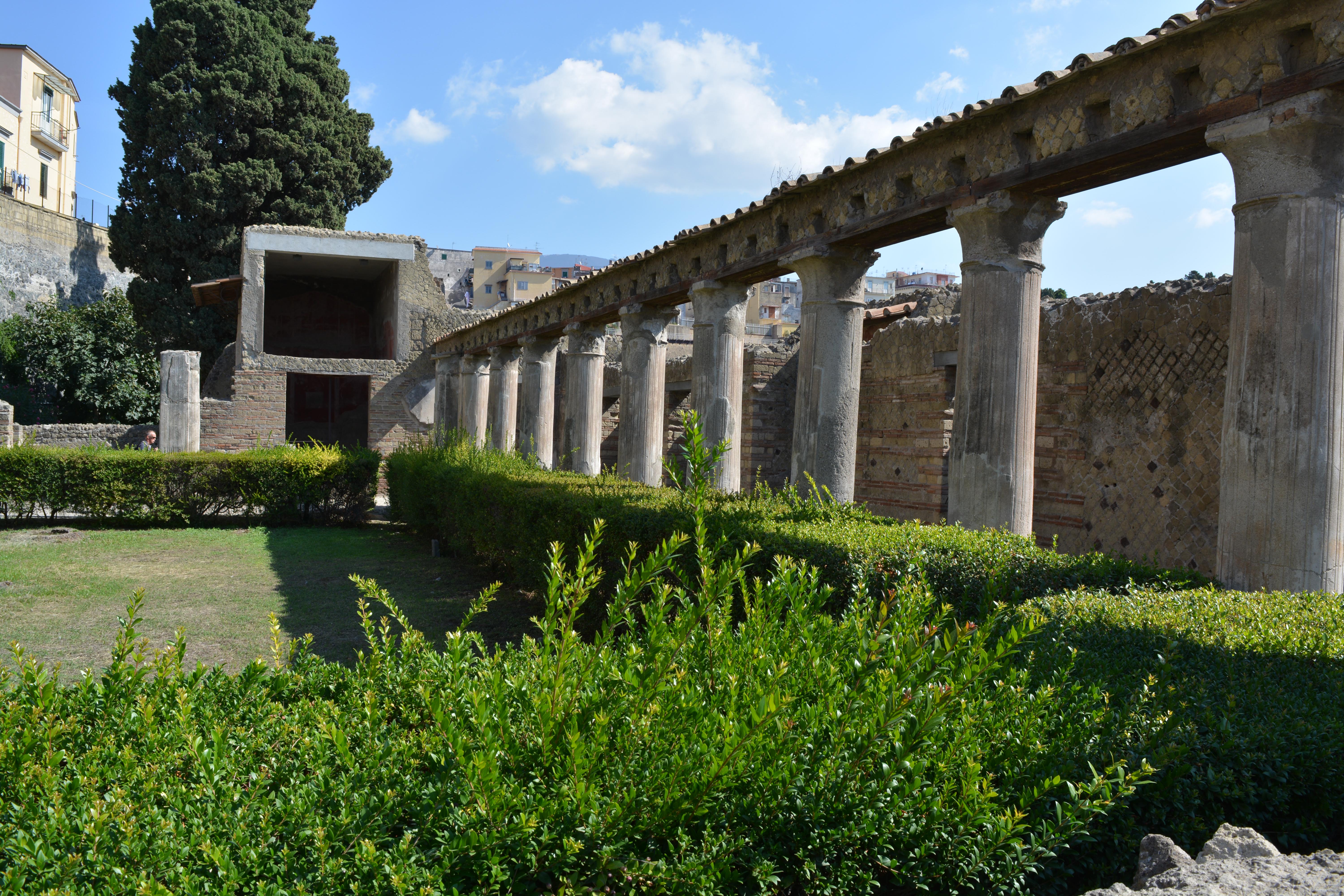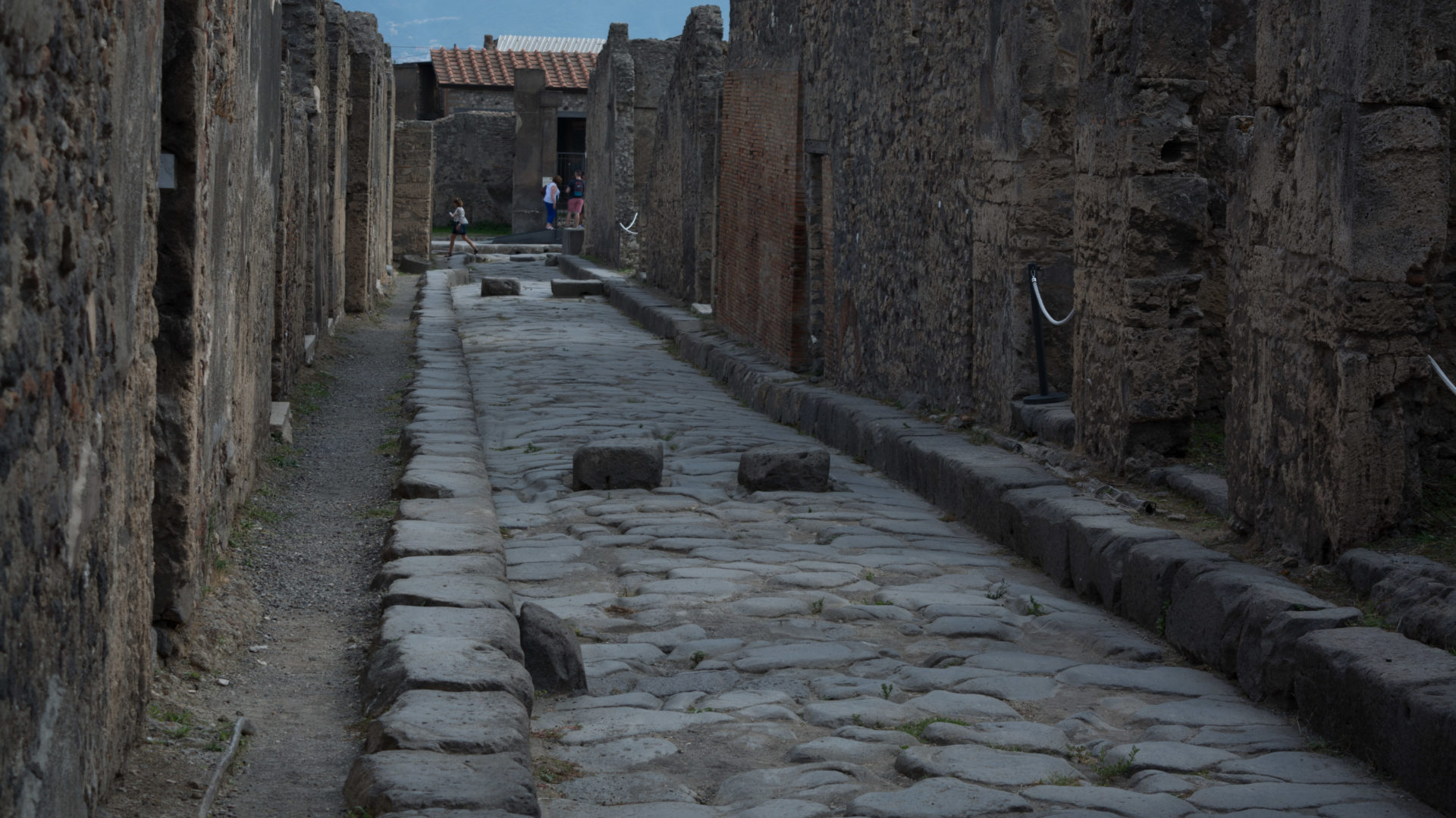I have decided to split this day’s photos into 2 posts again, because there is so much material. What follows is a lengthy explanation of the history and science of the eruption processes at Pompeii and Herculaneum. I know it is a lot to read, but please bear with me. It’s well worth it to understand how and why this incredible site looks the way it does.
On Day 6 we spent the morning at the ruins of Herculaneum. This is a smaller site than Pompeii, but even better preserved. Here some houses are intact up to the 3rd floor, and original woodwork can be seen in several places. Foodstuffs were also found here, most of which have been moved to nearby museums. There is also an abundance of skeletons, almost all of them concentrated in one area near the ancient shore.
The night before the visit we had a lecture at the Hotel during which Tony explained the different eruption processes that affected Pompeii and Herculaneum, and why these different processes led to different items being preserved (or not) in each site. It is helpful to recap a few of the points here.
Pompeii was located to the Southeast of Mt Vesuvius, and Herculaneum was located to the Northwest. Thus, when the eruption occurred, the two towns were on exactly opposite sides of the volcano. The initial part of the eruption consisted mostly of an ejection of ash and pumice, which reached tens of thousands of feet into the atmosphere. The wind carried most of the ash to the Southeast, in the direction of Pompeii, burying the town to a depth of about 8 feet. Some of the ash was blown as far as North Africa, where it left a layer about a third of an inch thick. Since Herculaneum was upwind of the volcano, very little ash fell there.
The second phase of the eruption consisted of a series of pyroclastic surges. These are rapidly-moving streams of superheated gas, which can move in certain directions depending on where and how the volcano ejects them. The gas in a pyroclastic flow moves at speeds around 200mph, and is heated to temperatures of several thousand degrees (comparable to the conditions produced by the atomic bombs dropped on Hiroshima and Nagasaki). These temperatures are hot enough to vaporize soft tissue instantly, leaving only skeletons behind. Harder organic matter, like wood and food, is scorched into carbon. This is why there are only skeletons at Herculaneum, but at Pompeii bodies buried in ash allowed casts of people and woodwork to be made.
At least 2 of these surges headed in the direction of Pompeii, which was already buried by ash, so most of the site was unaffected while any survivors were instantly killed. But Herculaneum, unprotected by ash, bore the full brunt of the rest of the surges. This suffocated, killed, and vaporized all of the people remaining in the town at the time the surges hit. The heat also carbonized (and preserved) wood and food exactly as it was at the moment of the eruption. These surges were followed by a massive landslide of hot volcanic mud, which built up in the crater during the eruption, and broke free through a weak spot that just happened to face directly towards Herculaneum. This hot mud slid down the side of the mountain and buried the town to a depth of 75 feet. Almost nothing was left above the mud after the eruption. Once the mud cooled it turned to solid rock, leaving the town buried, inaccessible, and completely forgotten.
Sixteen centuries ticked slowly by. The great Empire that Herculaneum was once a part of grew and stretched from Scotland to Iran, then collapsed. New powers rose and fell. Not far away, Pompeii was slowly picked over. Parts of buildings left protruding above the ash were gradually taken down and carted off. But Herculaneum, hidden beneath 75 feet of solid stone, lay untouched and forgotten. Everything stayed exactly as it had been on the day of the eruption.
This changed in 1709. A local person with no knowledge of Herculaneum was digging a deep well. By sheer luck, the well happened to go right down into the old theater, and eventually the man’s tool struck a magnificent Roman statue. By 1738 the Prince of Naples had acquired the land and was sponsoring excavations. Since removing the stone that covered the town was extremely difficult and time-consuming, the excavations were done by means of tunnels (similar to the Villas at Stabiae). The area was again abandoned when people decided to focus on Pompeii instead, since the ash there was easier to excavate. Over the course of the 19th and 20th centuries Herculaneum was excavated bit by bit, with the last major work being done in the 1990s and early 2000s.
In this photograph you can see the remarkably well-preserved ruins of Herculaneum, with houses and buildings intact up to the 3rd floor. The trees on the right of the image are growing on top of the material deposited by the eruption, which shows how deep the town was buried:

We entered the ruins through a long tunnel dug into the rock. Along the way the tool marks of the people who did the excavating are clearly identifiable:

Once we exit the tunnel we arrive at the beach, level with the ancient shoreline. Ground water is visible here, and Tony told us that back in the 1980s a pumping system was installed to keep the area dry during excavations. In front of us are the “boathouses,” small covered spaces which contain most of the roughly 300 skeletons found here. These were likely just storage spaces, where people trying to flee the eruption took shelter only to be overtaken by the pyroclastic surges:

Out of respect for the dead, I will not publish pictures of the skeletons. But many of them are still here. It is quite an experience to walk past the boathouses and see them lying exactly where they died almost 2,000 years ago.
Heading up from the beach and into the town, we encountered a large sarcophagus with a statue standing behind it. This is to commemorate a wealthy and prestigious local citizen, who was well-liked among the townspeople and was known for having freed many of the slaves he once owned:

Nearby is a room with lots of tile stacked up inside. This material was likely being staged here in order to be used to repair earthquake damage from the pre-eruption shocks. Inside and between the tiles, you can see that the volcanic mud made its way into every crack and crevice:

The first house that we entered was the House of the Telephus Relief. This is one of the largest and most luxurious houses in Herculaneum, and was owned by one of the city’s most prominent citizens. The relief on the wall depicts 2 scenes from Achilles’ journey to Troy. On the left Achilles is seen consulting with the Oracle, and on the right he is seen attempting to heal the wounds of Telephus with the rust on his spear.

Heading further into town we next entered the Palestra, a large exercise yard which has been partially excavated by a set of two tunnels which form a cross shape. At the center of the cross, where the two tunnels meet, is a bronze sculpture:

After walking down the street and around the corner, we entered the House of the Wooden Partition. This house is famous for the preserved wooden partition in the atrium, the ceiling of which stretches up several stories. In this picture we are gathered around the marble impluvium, with the partition behind us:

Here are some close-up shots of the partition:


A bed frame is also preserved in a room off the atrium:

Next we visited House Number 22, which has a stunning mosaic of Neptune and Salacia:

Across the street we entered the female section of the public baths, whose mosaic floor is perfectly preserved:

After this we went up the stairs to the House of the Black Saloon, and across the street we could see original iron bars still in the window of a nearby house:

The preservation of the frescoes in this house is breathtaking:




And the 2,000-year-old carbonized wood here looks like it was just charred yesterday:

The wooden door frame of this house is also carbonized, and although it has fallen apart bit by bit over the years, it still looks impressive:


There is a room at the front of this house that has been converted into a shop that sells wine, and the sign by the door indicates that this wine merchant also has a location in Nola.
In front of the house are the remains of a water tower, with the lead pipe in the center still intact (but the tank long gone). Beside the tower is this sign, which reads, “Dumping sewage by the water tower is prohibited. Free citizens found doing this will be fined, slaves will be flogged.” The Romans used different punishments for free people and slaves:

And across the street, a pair of wooden window shutters is still easily recognizable:

The last building we stopped in was the College of the Augustales, a temple with soaring ceilings and very well-preserved frescoes on the wall:



The woodwork in here makes it easy to see how the structure of the roof came together:

There is also a bedroom nearby, with a skeleton still lying on the bed. We were not able to go into the bedroom, however, because the door was closed:

At this point we had a few minutes to wander around Herculaneum on our own and visit the gift shop before getting on the bus for Boscoreale. I snapped a few pictures of the people and buildings on my way out:



And of course, I couldn’t resist snapping this shot of the ancient ruins and modern town with a dormant Vesuvius towering over them:

After all this, it is mind-blowing to realize that up to 75% of the ancient town may still be unexcavated. This illustration gives you a good look at the scale of the excavations so far: (Photo credit: Wikipedia)

In the Blue areas on the top, left, and right of the site is solid rock with modern homes and businesses built on top (Herculaneum was forgotten when those were built). Despite the allure of the discoveries waiting just feet away, excavations at Herculaneum are extremely difficult and slow-going, and it is unlikely that the entire town will ever be excavated. There are several reasons for this. The first is that currently inhabited buildings are standing on top of the volcanic material that covers the ruins, and excavating the Roman buildings underneath would require relocating or dispossessing the people in those homes and businesses. It is also very difficult to dig through the rock without damaging the ruins inside, because the mud that covered Herculaneum turned to stone after it cooled. Finally, it is impossible to do any sort of scientific survey (ground-penetrating radar, etc) to figure out what structures may be hiding and where, because the rock is the same density as the Roman concrete. So any survey conducted in the area would appear to be completely blank, even though massive ancient structures are surely hiding inside. The only way to know what is buried here is to dig very carefully, and wait. Thus, even though we know that most of the town is still left undisturbed and in exactly the condition it was in on the day of the eruption, we are extremely unlikely to see much more of it.
For my next post, I’ll cover the exhibits at the Antiquarium at Boscoreale. This is a small but impressive museum which holds many of the small everyday artifacts that were found here at Herculaneum, and some from Pompeii as well. Check back soon!
